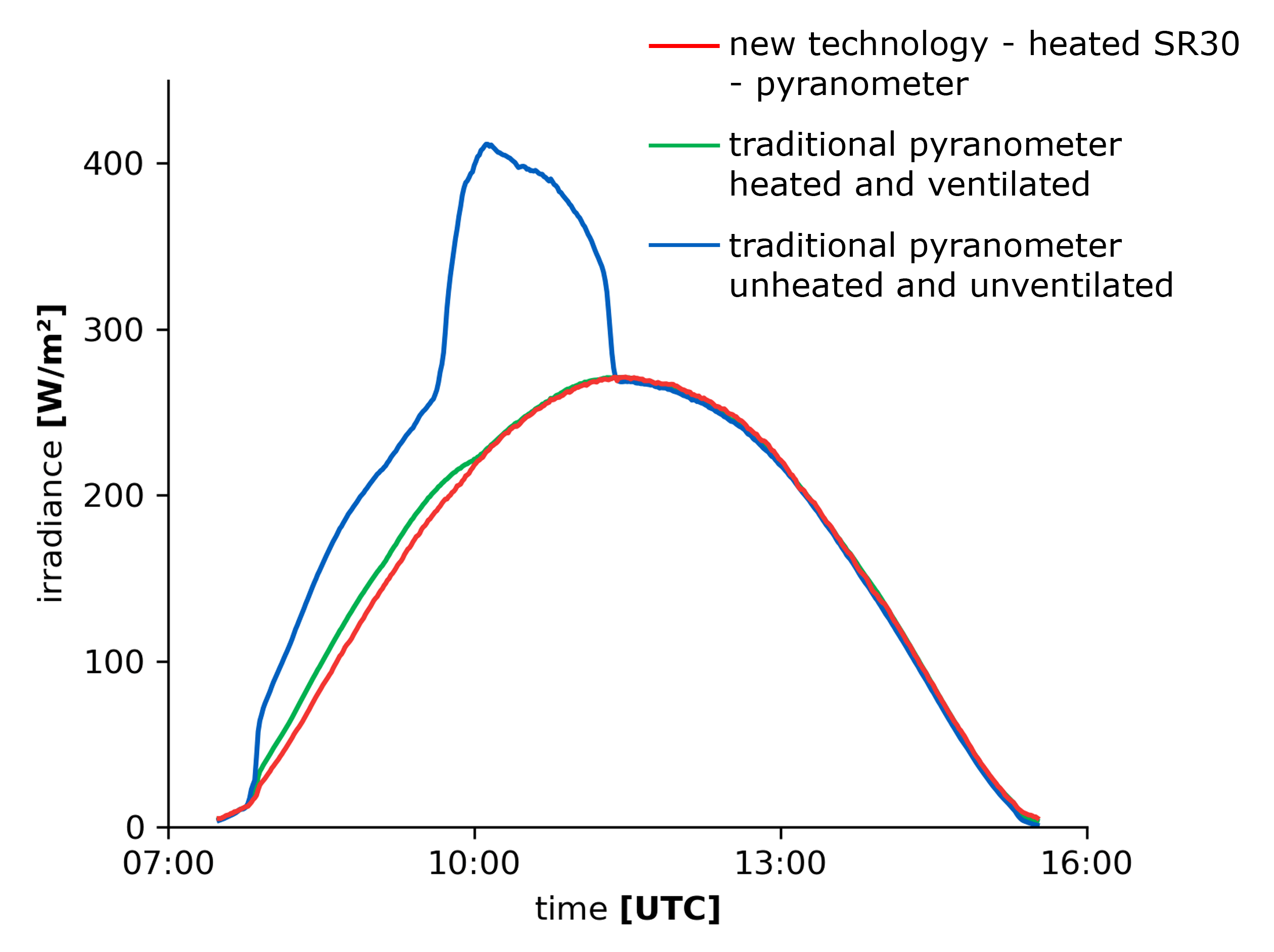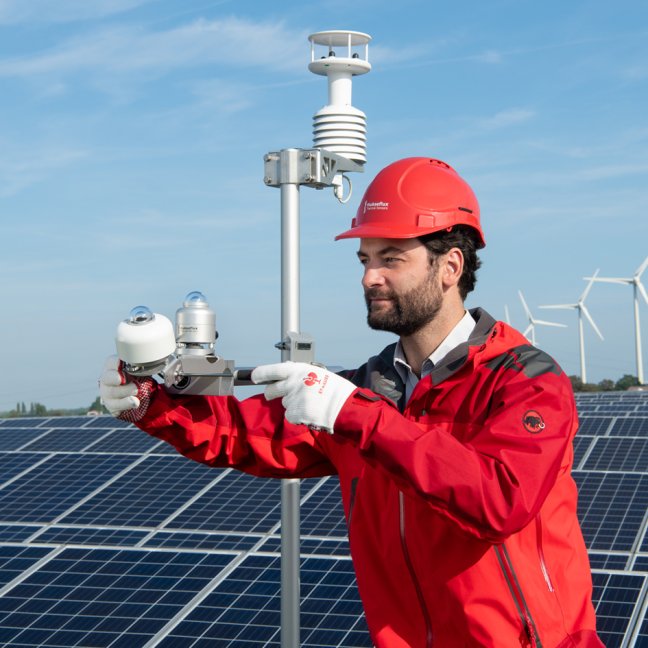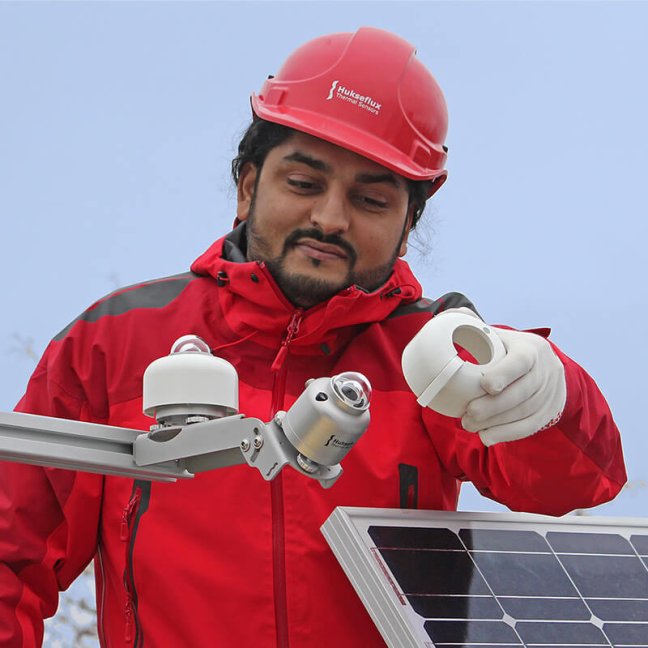Why heat pyranometers
Required for all high-accuracy measurements: improve data availability and reduce zero offset errors
Heating combined with ventilation of pyranometers has always been recommended by WMO, ISO and ASTM to reduce the effects of dew and frost, and to reduce zero offset errors. Now it is also a requirement for Class A systems for PV system performance monitoring according to IEC 61724-1. Hukseflux recommends all high accuracy measurements, aiming at a measurement accuracy of better than 5 %, to be equipped with heating. It is important to also be aware of the shortcomings of traditional external ventilation. Ventilation is NOT a way to reduce instrument cleaning or inspection interval. Ventilation is seldom effective to remove snow.
Read the full article here: Why heat pyranometers - note (PDF)
Introduction
In most climates deposition of dew and frost causes significant errors when measuring solar radiation. In particular in the early morning before instruments can be manually cleaned. Just heating a pyranometer by putting a resistor on it is not an option; it produces large zero offsets in a pyranometer thermal detector.
Hukseflux’ recommendation in summary
Hukseflux recommends to either use SR30 with “recirculating ventilation and heating” (Figure 1) or an external ventilation system such as VU01 with pyranometer SR20 (Figure 3):
- if you aim for a measurement accuracy of better than 5 % (k = 2)
- in all arctic conditions with regular frost
- if you work in utility scale PV monitoring according to IEC 61724-1 Class A
What not to do:
- use VU01 external ventilation and heating in area’s with high atmospheric dust loads (in that case use SR30)
Typical recommendations for use are:
- instrument cleaning interval < 7 days
- pyranometer calibration interval < 2 years
Exceptions to the recommendation are:
- when using Hukseflux model SR25: this model with sapphire dome may be heated without using ventilation, still having low zero offsets.

Traditional external ventilation
The traditional solution is an external ventilation system as in Figure 3. Heated and ventilated air is blown over the pyranometer.
This ventilator:
- heats air and blows it over the pyranometer so that the dome is kept above dew point
- promotes thermal equilibrium between all components of radiometers, and thereby reduces zero offsets
- usually employs extra heaters because the ventilator heating power may not be enough
- often introduces additional thermal zero- offsets, in particular at high power heating. High power heating is only recommended if necessary
- consumes a lot of power because the heat is carried away by ventilation air; typically around 10 W
- requires regular maintenance of the ventilator and air filters
- is not recommended for use in area’s with high atmospheric dust loads such as deserts with regular sand storms; rotating parts of ventilators tend to get stuck and are not designed to be cleaned
- does not reduce the pyranometer cleaning interval (reference ISO, WMO, BSRN, see below)
- does not reliably prevent snow or rain deposition on a dome
New: SR30 with internal recirculating ventilation and heating
A new solution is heating by internal recirculating ventilation as applied in SR30. Internally heated and recirculated air keeps the instrument dome above the dew point and at the same time it forces the body to the same temperature.
Internal ventilation:
- heats air and blows internally through the instrument so that the dome is above dew point
- makes sure the entire pyranometer is in thermal equilibrium, reducing zero offsets
- does not require extra heaters
- at high heating has no additional zero-offsets
- consumes low power because the heat is recirculated inside the instrument only; 2 W power consumption is normal
- requires replacement of the ventilator after > 5 years
- does not reduce the pyranometer cleaning and inspection interval (reference ISO, WMO, BSRN see below)
- does not reliably prevent snow or rain deposition on a dome
Maintenance / cleaning
Heating and ventilation are typically used if there are high-accuracy measurement requirements. In such case the need for a high level of instrument maintenance and dome cleaning and inspection (keeping a record of visually confirmed proper condition) still exists; evaporating droplets of water might leave stains on the instrument domes. The bottom of external ventilation units usually provides access to the removable dust filter which needs regular cleaning.

Generally recommended practices ISO TR9901 and ASTM G 183-05
ISO/TR 9901 “Solar Energy - Field Pyranometers - Recommended practice for use”, recommends use of heating by ventilators where high accuracy and reliability are required. It adds in 5.2.2 3 its specific purposes:
- dew and frost formation are inhibited, especially from the outer dome,
- rain droplets on the outer dome are evaporated quickly, and
- the temperature of the instrument is maintained near to that of the ambient air.
Annex A1 adds: “Generally, pyranometers are ventilated continuously in order to provide a high level of reliability”. More details can be found annex A2 which comments on different ventilation systems.
The maintenance schedule of pyranometers is described in chapter 5.2.3 and recommends daily cleaning of pyranometers, irrespective if they are heated and ventilated or not.
ASTM G 183-05 “Standard Practice for field use of pyranometers, pyrheliometers and UV radiometers” is the ASTM equivalent of ISO TR9901.
In 5.3.2 it recommends daily inspection and cleaning of the instrument and a weekly check of operational state of the ventilator.
IEC 61724-1: use for PV system performance monitoring
For class A and B systems you may use PV reference cells as well as pyranometers. According to table 5 pyranometers and PV reference cells must be heated. The purpose of the heating is mentioned in the same table: “to prevent accumulation of condensation and/or frozen precipitation”, which is the main source of unreliable data in most climates. It is “required in locations where condensation and/or frozen precipitation would affect measurements on more
than 7 days per year” for class A, and “more than 14 days per year” for class B. In class A systems only the pyranometers must be ventilated; the PV reference cells do not require ventilation because they do not suffer from zero offsets.
The IEC 61724-1 standard requires pyranometer “cleaning” also per table 5; at least once a week for Class A systems, once every 2 weeks for class B.

WMO: use in meteorological networks
About ventilation: in 7.3.3.5: “in some networks, the exposed dome of the pyranometer is ventilated continuously by a blower to avoid or minimize deposits in cold weather, and to cool the dome in calm weather situations. The temperature difference between the ventilating air and the ambient air should not be more than about 1 K. If local pollution or sand forms a deposit on the dome, it should be wiped very gently, preferably after blowing off most of the loose material or after wetting it a little, in order to prevent the surface from being scratched.”
About maintenance in 7.3.3: “It is most desirable that pyranometers and recorders be inspected at least daily, and preferably more often.”
BSRN: use with high accuracy diffuse radiation measurement
The Baseline Surface Radiation Network, BSRN, is a high quality network for climate change monitoring. It requires ventilation for all pyranometers in its BSRN operations manual v2.1.
In the BSRN network pyranometers are primarily used for measurement of diffuse irradiance. On a diffuse signal in the order of 200 W/m2, a zero offset of the order of 7 W/m2 is very significant. Ventilation reduces this by a factor 2.
The primary purpose of ventilation in the BSRN network is reduction of zero offsets.
The BSRN manual in 4.2.2.1 recommends ventilation as a tool against zero offsets, dew, frost and snow. The manual says:
“The recommended procedures for the measurement of global radiation require the use of a ventilated housing to improve the overall stability of pyranometer measurement by damping changes in the pyranometer body temperature due to solar loading and potentially reducing the thermal offset. In some climates, the use of a ventilator also improves the amount of recoverable data by eliminating dew and reducing the number of occurrences of frost and snow on the instrument domes.
Locations where a ventilated housing are recommended are:
- where dew, frost or snow is prevalent,
- where natural ventilation is infrequent or variable,
- where there is significant radiative cooling during portions of the year, a ventilated housing may reduce thermal-offset,
- where the humidity is high during portions of the year a ventilator will reduce the possibility of water damage and reduce the frequency of desiccant changes”.
The Maintenance schedule as described in chapter 6 of the BSRN manual, recommends instrument cleaning as well as checks of the ventilator once per day, lubrication or cleaning of ventilators every year.
...
Read the full article here:









